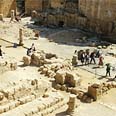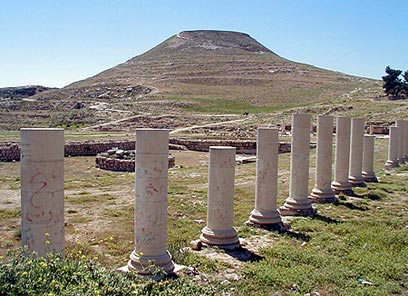
King Herod's tomb discovered, Israeli university says
Hebrew University professor says researchers have been searching for Roman king's grave for over 30 years, discovery of tomb near Jerusalem provides solution to one of most intriguing mysteries of Israeli archeology
The University said in a brief statement the discovery was made at Herodium, where Herod's hilltop fortress palace once stood some 7 miles from Jerusalem.
Professor Ehud Netzer, from the Department of Archeology at the Hebrew University, said at a press conference on Tuesday that researchers have been searching for the grave for over 30 years, and that the discovery provided a solution to one of the most intriguing mysteries of Israeli archeology.
The Herodium excavations began in 1972 with assistance from the Society for the Reclamation of Antiquities. In August 2006, digging began on the north-eastern slope of the mountain. Monumental steps, six-and-a-half meters (over 20 feet) wide provided access to the grave.
Most of the mausoleum has been taken apart over the years. What remains is the 100 square meter (over 1,000 feet) stone foundation.
Within the ruins, archeologists found pieces of the sarcophagus that held the king's remains. The coffin, 2.5 meters (8.2 feet) long is made of pinkish Jerusalem stone, with bronze embellishments. It was smashed, most probably during the first rebellion against the Romans between 66-72 CE.
In 2006, when it became clear that the grave itself was not inside the burial plot, the archeologists decided to shift their efforts to the slope. "We believe that Herod had planned to be buried at the foot of the mountain, in the burial plot, but as he grew older he changed his mind and decided to be buried on the mountain. Netzer explained. "We are positive that having found the grave, the number of visitors at this national park will increase," he stated.

The Roman Senate appointed Herod "King of the Jews" in approximately 40 BCE. He was also well-known for the magnificent structures built at his behest. In addition to the Herodium fortress, he was responsible for the building of Masada and the expansion of the Second Temple in Jerusalem.
He also created new cities such as Caesaria and Herodion. According to the ancient Jewish historian Falavius Josephus, Herod died in 4 BCE.
Herod is mentioned in Christian tradition, as well as Jewish tradition: The Gospel of Matthew says heordered the "Massacre of the Innocents", the killing of all young male children in Jesus' birthplace of Bethlehem out of fear he would lose his throne to a new "King of the Jews", whose birth had been related to him by the Magi.
According to Matthew, Joseph and Mary fled with baby Jesus to Egypt to escape the slaughter.
Shaul Goldstein, head of the Gush Etzion council, where the Herodium is located, said that the discovery would turn the area into a site of global and religious importance.
"The discovery is another proof of Gush Etzion's direct link to the history of the Jewish people and Jerusalem and we must prepare for tens of thousands of visitors," he added.
Reuters contributed to the report










